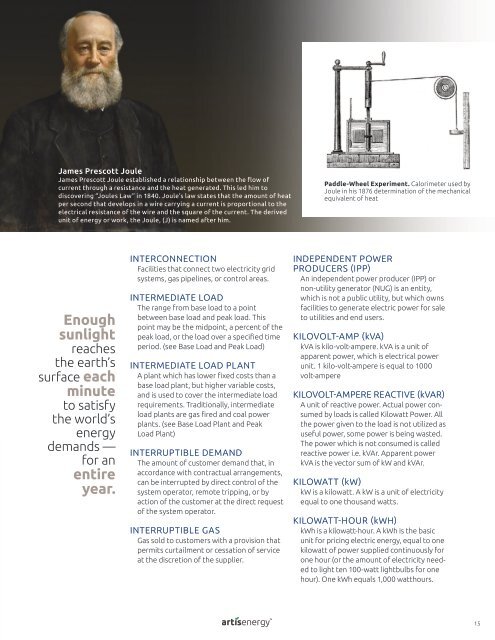Artis Energy Intelligence - Magazine Summer 2019
Create successful ePaper yourself
Turn your PDF publications into a flip-book with our unique Google optimized e-Paper software.
James Prescott Joule<br />
James Prescott Joule established a relationship between the flow of<br />
current through a resistance and the heat generated. This led him to<br />
discovering “Joules Law” in 1840. Joule’s law states that the amount of heat<br />
per second that develops in a wire carrying a current is proportional to the<br />
electrical resistance of the wire and the square of the current. The derived<br />
unit of energy or work, the Joule, (J) is named after him.<br />
Paddle-Wheel Experiment. Calorimeter used by<br />
Joule in his 1876 determination of the mechanical<br />
equivalent of heat<br />
Enough<br />
sunlight<br />
reaches<br />
the earth’s<br />
surface each<br />
minute<br />
to satisfy<br />
the world’s<br />
energy<br />
demands —<br />
for an<br />
entire<br />
year.<br />
INTERCONNECTION<br />
Facilities that connect two electricity grid<br />
systems, gas pipelines, or control areas.<br />
INTERMEDIATE LOAD<br />
The range from base load to a point<br />
between base load and peak load. This<br />
point may be the midpoint, a percent of the<br />
peak load, or the load over a specified time<br />
period. (see Base Load and Peak Load)<br />
INTERMEDIATE LOAD PLANT<br />
A plant which has lower fixed costs than a<br />
base load plant, but higher variable costs,<br />
and is used to cover the intermediate load<br />
requirements. Traditionally, intermediate<br />
load plants are gas fired and coal power<br />
plants. (see Base Load Plant and Peak<br />
Load Plant)<br />
INTERRUPTIBLE DEMAND<br />
The amount of customer demand that, in<br />
accordance with contractual arrangements,<br />
can be interrupted by direct control of the<br />
system operator, remote tripping, or by<br />
action of the customer at the direct request<br />
of the system operator.<br />
INTERRUPTIBLE GAS<br />
Gas sold to customers with a provision that<br />
permits curtailment or cessation of service<br />
at the discretion of the supplier.<br />
INDEPENDENT POWER<br />
PRODUCERS (IPP)<br />
An independent power producer (IPP) or<br />
non-utility generator (NUG) is an entity,<br />
which is not a public utility, but which owns<br />
facilities to generate electric power for sale<br />
to utilities and end users.<br />
KILOVOLT-AMP (kVA)<br />
kVA is kilo-volt-ampere. kVA is a unit of<br />
apparent power, which is electrical power<br />
unit. 1 kilo-volt-ampere is equal to 1000<br />
volt-ampere<br />
KILOVOLT-AMPERE REACTIVE (kVAR)<br />
A unit of reactive power. Actual power consumed<br />
by loads is called Kilowatt Power. All<br />
the power given to the load is not utilized as<br />
useful power, some power is being wasted.<br />
The power which is not consumed is called<br />
reactive power i.e. kVAr. Apparent power<br />
kVA is the vector sum of kW and kVAr.<br />
KILOWATT (kW)<br />
kW is a kilowatt. A kW is a unit of electricity<br />
equal to one thousand watts.<br />
KILOWATT-HOUR (kWH)<br />
kWh is a kilowatt-hour. A kWh is the basic<br />
unit for pricing electric energy, equal to one<br />
kilowatt of power supplied continuously for<br />
one hour (or the amount of electricity needed<br />
to light ten 100-watt lightbulbs for one<br />
hour). One kWh equals 1,000 watthours.<br />
15


